Divergent “industrial strategies” in the U.S., China and Europe can create the security to open up.

Mia Angioy for Noema Magazine
The remarkable story future historians will tell about the late 20th and early 21st century is how inviting a Communist Party-state to enter a global economy built on the capitalist principles of free trade and markets ended up transforming the neoliberal West into a bastion of protectionism and state-directed industrial policy of the same kind now condemned as unfairly advantaging China’s rise.
They will also note the further irony that the logic of opening to China in the 1970s — and of China’s opening to the West — had a national security premise of checkmating the Soviet Union. Half a century on, the Middle Kingdom is more closely aligned with Russia than in the later stages of the Cold War, primarily as a way to do the opposite: checkmate America’s continuing dominance of the very world order that enabled its rapid ascent.
Adding more complexity to this reversal of history are the related global challenges that have arisen in both East and West: decarbonization of fossil-fuel dependency to mitigate climate change while coping with the disruptions of the digital revolution and the advent of artificial intelligence.
From Deglobalization To Competitive Industrial Strategies
These threads of deglobalization, climate and technological revolution have all converged in the competitive assertion of “industrial strategies” in which nation-building is integrally bound up with international security concerns. China is driven by the fear of not catching up, the United States by alarm at losing the upper hand and Europe by the angst of falling behind both and losing its strategic autonomy.
China’s industrial strategy is called “dual circulation,” essentially a policy of self-reliance and resilience in the face of newfound Western hostility. It is aimed at bolstering domestic consumption and production, including conquering the latest AI technologies with its own resources, while off-loading manufacturing overproduction abroad and expanding trading ties in the global South.
The U.S. strategy, as crafted by President Joe Biden, encompasses a broad array of protective tariffs and subsidies. The CHIPs Act and related policies seek to foster homegrown microchip production while denying frontier technologies to China and restructuring supply chains to friendly nations. The Inflation Reduction Act promotes extensive new investment in the green energy transition. Incongruously, at the same time, a tariff of 100% has been imposed on the import of Chinese electric vehicles. Further tariffs on component inputs, such as batteries sourced in China, are already on track.
Europe’s Big Chance
Following the U.S, the European Union is also set to raise its own stiff tariff hikes on Chinese EVs as it pursues a European Green Deal to transition to renewables on its own terms. Europe also seeks to blunt the impact of the “buy American” restrictions of the IRA so that fleeing capital looking to exploit the subsidized U.S. market does not hollow out its own green industries before they can be firmly established.
Earlier this month, the former European central banker and one-time Italian prime minister, Mario Draghi, has gone the next step and plotted out a detailed, long-term “industrial strategy” to close the gap with the U.S. and China, which he calls “an existential challenge” to the European way of life.
“If Europe cannot become more productive,” Draghi writes in his report, “we will be forced to choose. We will not be able to become, at once, a leader in new technologies, a beacon of climate responsibility and an independent player on the world stage. We will not be able to finance our social model. We will have to scale back some, if not all, of our ambitions.”
He goes on: “Europe’s fundamental values are prosperity, equity, freedom, peace and democracy in a sustainable environment. The EU exists to ensure that Europeans can always benefit from these fundamental rights. If Europe can no longer provide them to its people — or has to trade off one against the other — it will have lost its reason for being. The only way to meet this challenge is to grow and become more productive, preserving our values of equity and social inclusion. And the only way to become more productive is for Europe to radically change.”
To boost productivity, Draghi calls for bolstering the single market to temper national fragmentation, loosening merger rules to enable scaling up of enterprises, and an annual investment of 800 billion euros financed through a controversial plan, resisted so far by key member states like Germany, of floating massive debt at the EU level.
The former central banker calculates that targeted spending of those borrowed billions on subsidies and investments, especially in tech innovation, will pay for itself by raising European-wide productivity by 2%, while empowering the continent to compete with China and the U.S.
One approach that would make Draghi’s plan more politically palatable is to marry it with EU President Ursula von der Leyen’s proposal for a European Sovereign Wealth Fund. If Draghi’s debt is used to seed such a SWF, modeled on Australia’s superannuation fund — essentially a supplemental retirement savings/investment plan for all citizens, the average European could share directly in the profits of rising productivity across the revived manufacturing and new tech sectors.
The Australian fund was initiated by a Labor prime minister, Paul Keating, in 1992. Following a doubling of productivity growth stimulated by deregulation of financial markets, tax cuts and wage bargaining at the enterprise level, Keating sought to capture the wealth created for individual Australians through an employee/employer mandated contribution to the newly established superannuation fund.
That savings pool, which has now grown to nearly $4 trillion, stands at about 230% of GDP. The enormous fund invests its assets around the world and in Australia, including in infrastructure, the financing needs of which are a fitting match for its long-term capital. The return on those investments to the plan’s participants has reduced inequality in the country while making Australia among the nations with the highest average wealth in the world at $ 773,000 per voting age adult.
Will It Work?
For all these divergent industrial strategies to succeed in the end depends largely on whether sustained nation-building investment outstrips the duration of protective measures that ought to be only a temporary respite from asymmetrical conditions while they are rebalanced.
To the extent these decoupled initiatives do succeed, they will, paradoxically, come to be regarded not as the antithesis of global cooperation, but as the precondition for it. Only when the power centers of China, the U.S. and Europe are assuredly in control of their own destiny will they be secure enough to open up and cooperate on the global issues that impact them all equally.
By Nathan Gardels - From NoemaMag









